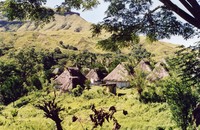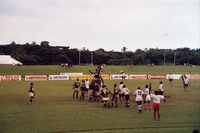Fiji
 The Fijian Archipelago is made up of over 300 islands, the largest being Viti Levu which is also the most populous and where the capital Suva is located. Vanua Levu is a smaller, more rugged and traditional version, where life is centred more on sugar cultivation than tourism. It is not hard to see why the area is such a popular site for castaway reality TV programs. Each island is surrounded by reef which protects the beach from waves and provides good surfing and snorkelling opportunities and the larger islands have lush mountainous regions inland. The buildings reflect the many aspects of Fijiâs culture with the colonial 19th century wooden sea fronts, Methodist Churches and traditional grass-roofed Bures.
The Fijian Archipelago is made up of over 300 islands, the largest being Viti Levu which is also the most populous and where the capital Suva is located. Vanua Levu is a smaller, more rugged and traditional version, where life is centred more on sugar cultivation than tourism. It is not hard to see why the area is such a popular site for castaway reality TV programs. Each island is surrounded by reef which protects the beach from waves and provides good surfing and snorkelling opportunities and the larger islands have lush mountainous regions inland. The buildings reflect the many aspects of Fijiâs culture with the colonial 19th century wooden sea fronts, Methodist Churches and traditional grass-roofed Bures.
Despite several military coups being well within living memory, the inhabitants of Fiji are incredibly friendly and welcoming. In the busier cities visitors are encouraged to shop, eat and drink, by enthusiastic vendors where everyone seems to be related. In more remote areas this approach is maintained and people will readily invite you to their village, often without motive.
Pace of life is kept slow by the preoccupation with ritual and consumption of kava, the medicinal peppery root which is crushed and drunk at almost every conceivable occasion.
Language
 The official language is English and it is widely spoken and understood. Fijian and its many local dialects are also still very much in use verbally and in books and newspapers.
The official language is English and it is widely spoken and understood. Fijian and its many local dialects are also still very much in use verbally and in books and newspapers.
Some useful phrases: Bula â an informal greeting, failing to say this on passing may appear quite rude. E-o â yes. Sayngha â no. Vinakha â thank you.
Currency
Fijian dollars (FJD). £1 to $3.2 FJD, $1 USD to $1.7 FJD and â¬1 to $2.2 FJD (19/08/06). Despite being recognised as a republic since 1987, notes still bear the face of Queen Elizabeth on one side.
Weather
Fiji has a tropical maritime climate with temperatures rarely dropping below 20ËC. November to April sees Fijiâs summer which is hot and humid with the highest rainfall. The cooler and drier months of May to October provide the best time to visit. The weather can across the larger islands with prevailing trade winds forcing cloud and rain to the South-East, giving rise to a warm, wet and lush environment.
Attractions
 Coral Coast â The South West coast of Vitu Levu has everything from mangroves, beach and rainforests and can be easily explored from the many resorts that line the coast. Sigatoga is a great base from which to explore the region, book dive or surf trips and watch a regional rugby match.
Coral Coast â The South West coast of Vitu Levu has everything from mangroves, beach and rainforests and can be easily explored from the many resorts that line the coast. Sigatoga is a great base from which to explore the region, book dive or surf trips and watch a regional rugby match.
Island of Ovalau - A short but exhilarating flight from Suva (landing on a grass runway) provides unique views of the coral reef and brings you to a place which has not changed for some time. The sleepy colonial capital looks like something from a western and has a great choice of accommodation and dining.
Village Visit â Since being listed in Lonely Planet guidebooks, some villages have begun charging admission to view the grass topped settlements. Manage to avoid these however and you will be most likely be treated well, fed, investigated by the younger generations and possibly asked for a small donation on your departure.
Shopping
Most will be lucky to leave without a set of hand carved Kava bowls which are about as functional to drink out of as half a coconut, which is what most started life as. There are a massive amount of quality craft goods on offer which can be purchased from the more expensive outlets in Nadi or Suva or directly from the village craftspeople themselves. More generic hand carved wooden goods can be heavily bartered for at markets and smaller shops along with all manner of brightly coloured Fiji Bitter t-shirts and vests. Black pearls and spices are also available at bargain prices.
Nightlife
Outside of Suva or the Yasawas, the evenings tend to be quite peaceful. Smaller towns usually have a few bars or restaurants, although these are sometimes accompanied by an unfriendly local crowd of heavy drinkers. Nadi has several clubs exemplary of this such as Planters or McGeeâs. Most clubs in Suva are not safe places for tourists, with the possible exceptions being Traps or Wolfhound although itâs best to travel only by taxi after dark. The Yasawa islands are becoming increasingly popular with gap-year travellers and backpackers. The most popular are âbudgetâ resorts which take cards and passports on arrival, allowing guests to enjoy the sandy beaches and hedonism while unwittingly amounting staggering bar bills.
Driving
Vitu Levu has a fully sealed highway running its circumference and a sealed highway runs the length of Vanua Levu. The majority of the remaining roads are unsealed and unpredictable with small landslides possible after sudden downpours. The standard of driving can be poor and roads are used as footpaths by humans and animals which in addition to the prevalence of drink driving, means that driving at night is not advisable. Drink driving is illegal and the blood alcohol concentration limit is set at 0.08%. Driving is on the left and it is compulsory to pick up hikers although this does not extend to tourists in hire cars.
Food and Drink
Fijian food consists of rice, root vegetables, fish and meat with spices generally added after cooking although vegetarian food often tends to be better. Fijian Indian curries offer a more flavoursome alternative although they will still seem less rich than most travellers are accustomed to.
Kava is the national drink, with important customs surrounding its consumption. It tastes like muddy peppery water but the numbing effects soon dull the taste and lethargy and mild incoherence eventually follow.
Alcohol is widely available apart from some of the smaller Methodist run islands, and the locally brewed Fiji Bitter is superb.
Tourist Information
Fiji Visitors Bureau, Thomson Street, PO Box 92, SuvaTel. +679 3302433Fax. +679 3300970/3302751www.BulaFiji.cominfodesk@fijifvb.gov.fj
There is another official tourist office at Nadi Airport and various other offices in the larger towns, often affiliated with tour operators.



